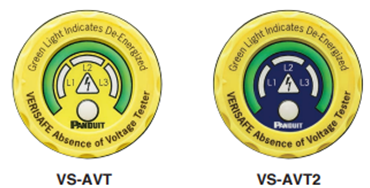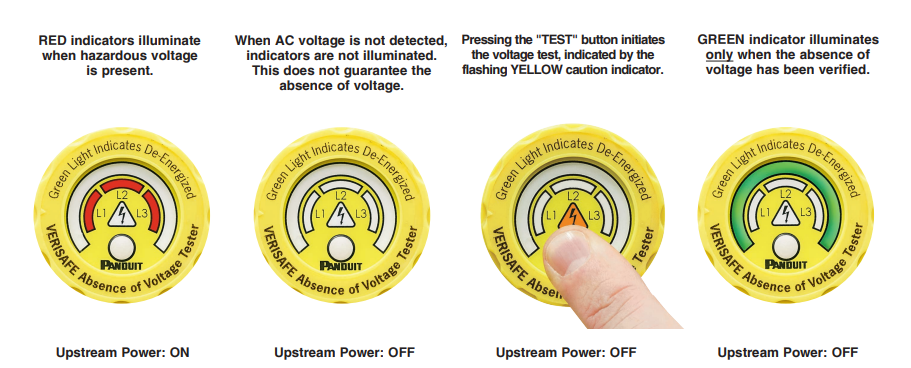VeriSafe™ Absence of Voltage Tester
 When servicing electrical equipment, workers must comply with safety regulations that require a voltage verification test to validate the absence of voltage. This process includes a number of stages that can be complex and time-consuming when using hand-held portable test instruments.
When servicing electrical equipment, workers must comply with safety regulations that require a voltage verification test to validate the absence of voltage. This process includes a number of stages that can be complex and time-consuming when using hand-held portable test instruments.The VeriSafe™ Absence of Voltage Tester from Panduit simplifies this process by automating the voltage verification process.
Once installed, a simple push of a button enables workers to verify the absence of voltage and see an active indication when the absence of voltage is confirmed. This provides a new and innovative way to safely, reliably, and efficiently verify the absence of voltage before accessing potentially dangerous electrical equipment.

By automating this process, the VeriSafe™ Absence
- Reduces the risk of exposure of electrical hazards for improved worker safety
- Reduces testing procedure time and complexity to improve productivity
- Supports compliance when used to verify the electrical lockout/tagout process as described in NFPA 70E
The VeriSafe™ Absence of Voltage Tester minimizes risk by verifying the absence of voltage before equipment is assessed, making it easier for workers to verify an electrically safe work condition has been established in a fraction of the time compared to using hand-held portable test instruments.
Features and Benefits
- Improved Safety & Risk Reduction: Determine voltage status BEFORE equipment is accessed. Prevents direct exposure to electrical hazards.
- Increased Productivity: Easy to use, initiate test with the push of a button. No additional tools required. Provides visual alert to abnormal power conditions.
- Simplified Process for Easier Compliance: Test sequence based on the steps in NFPA 70E for verification of an electrically safe work conditions. Automated test helps reduce operator costs.
- Reliable Results: Fail-safe design with active indications. Safety functions meet SIL 3 per IEC 61508-1.
- Flexible Applications: Designed for testing three-phase circuits up to 600V. Install on line or load side or electrical disconnect.
- Multiple Environments: All VeriSafe™ Absence of Voltage Testers are tested to Type (UL, NEMA, and CSA) 1, 12, 13, 4X, IP66, or IP67 VS-AVT2 parts are rated to Class 1 Division 2, and Class 1 Zone 2 environments
Electrical Safety
Prior to performing de-energized work on electrical equipment, NFPA 70E requires that workers verify equipment is in an electrically safe state. Until proven otherwise, equipment must be treated as energized and necessary precautions must be observed.
One of the steps in the process of verifying that equipment is in an electrically safe state involves a test for the absence of voltage.
Verifying the Absence of Voltage
Before and after testing, the functionality of the tester must be verified on a known source. When using a portable tester, this is a time-consuming process and may involve exposure to electrical hazards.
Using the VeriSafe™ Absence of Voltage Tester reduces risk and ensures the entire process is performed in the proper sequence - every time, every test.
More than a Voltage Indicator
Voltage indicator warn of hazardous voltage, but cannot be used to confirm if equipment is de-energized. Absence of Voltage Testers are permanently-mounted test devices designed to verify that a circuit is de-energized prior to opening an electrical enclosure containing electrical conductors and circuit parts.
Shop now to experience innovative process automation.
